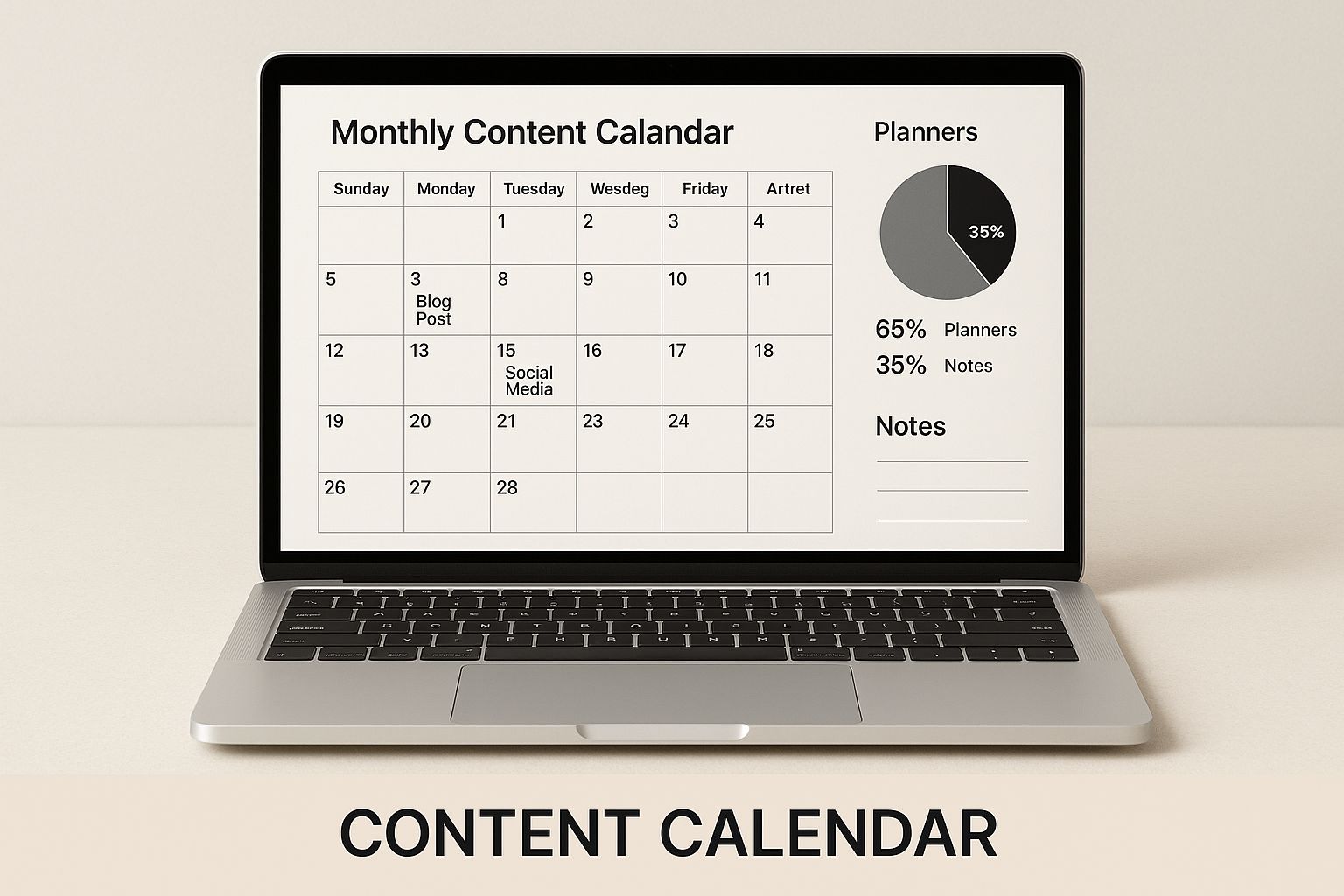A solid social media marketing plan is your roadmap. It's what separates posting on a whim from a deliberate strategy that actually grows your business. Think of it as the difference between just shouting into the void and having a real conversation with people who want to listen—and buy. A good plan will help you increase brand awareness, generate leads, and build lasting customer loyalty.
Building Your Strategic Foundation

Before you even think about what to post, you need to lay the groundwork. This is where so many businesses go wrong. They jump straight into creating content without any real direction, then wonder why nothing is happening. A strong foundation ensures every single thing you do on social media pushes you closer to your ultimate business goals.
It all starts with getting practical and tying your social media efforts to tangible business outcomes. Forget vague aspirations like "getting more followers"—that's a vanity metric that won't pay the bills. You need specific, measurable targets that have a real impact.
Define Your Business Objectives
First things first: what do you actually want social media to do for your business? Is it about driving more traffic to your website so people can see your products? Or maybe you need to generate concrete leads for your sales team to follow up on.
Here are a few examples of what strong, business-focused objectives look like:
- Increase website traffic from our social channels by 25% over the next quarter.
- Generate 30 quality leads each month using LinkedIn and Facebook.
- Boost online sales attributed to social media by 15% within six months.
- Cut down on support emails by 10% by using social media as a primary customer support channel.
See the difference? These goals are specific, time-bound, and easy to track. They create a direct line between your social media activity and your business's performance, making it much easier to see a real return on your investment.
Key Takeaway: Your social media goals must mirror your business goals. If your priority is boosting local sales, it makes no sense to chase thousands of followers in another country. Everything needs to be aligned.
Conduct a Realistic Social Media Audit
With clear objectives in place, it’s time for an honest look in the mirror. A social media audit means digging into your current profiles, your performance, and what your competitors are up to. This process is invaluable for figuring out what’s working, what’s a waste of time, and where your biggest opportunities are hiding.
Your audit should get to the bottom of a few critical questions:
- Where are we now? List all your current platforms. Are they still the right places to find your target audience?
- How are we doing? Look at the hard numbers—engagement rates, reach, and click-throughs.
- Who are we talking to? Analyse the demographics of your followers on each platform. Do they match your ideal customer profile?
- What content actually works? Pinpoint your top-performing posts. This is a goldmine of information about what your audience truly cares about.
This isn't just an internal review; you also need to size up the competition. See what your main rivals are doing online. Note their active platforms, the kind of content they share, and how much engagement they get. The goal isn’t to copy them, but to find gaps you can exploit. For example, if your biggest competitor is crushing it on Facebook but has ignored Instagram, you may have just found your opening.
To pull all of this together, using a structured social media marketing plan template can give you a clear framework to follow.
A Real-World Scenario
Let’s take a UK-based artisan coffee shop. Initially, their goal was simply "brand awareness." An audit quickly showed they had followers from all over the country, but very few were actual customers walking through the door. Their real business goal was to increase local footfall.
So, they pivoted. Their new, smarter objective became: "Increase in-store visits from local residents by 20%."
Their content strategy changed completely. They stopped posting generic coffee photos and started running targeted Instagram Stories featuring daily specials for locals. They became active in local Facebook community groups. This simple strategic shift, born from a clear goal and an honest audit, turned their social media from a vanity project into a genuine source of revenue.
Pinpointing Your Ideal UK Audience
Let’s be honest: a social media plan without a crystal-clear audience in mind is like trying to have a conversation in an empty room. To get any real traction, you have to move beyond vague ideas and truly get inside the heads of your UK customers. What makes them tick? Where do they hang out online? Answering these questions is the difference between creating content that actually converts and just adding to the digital noise.
Shouting your message from the rooftops guarantees you'll connect with no one. The real magic happens when you build detailed customer personas. These aren't just make-believe characters; they're research-backed profiles of your ideal buyers. They should feel like real people with genuine problems and online habits.
This deep understanding is what turns a generic plan into a powerhouse for growth. It’s especially true for local businesses. If you're a local business, knowing your community's habits can directly shape your content. For instance, if you need help with this on a local level, a specialist service for social media marketing in Norfolk can offer those crucial, region-specific insights.
Going Beyond Basic Demographics
It’s easy enough to jot down an age range, gender, and location. That’s a start, but it’s barely scratching the surface. To build a social media plan with teeth, you need to dig into psychographics—the why behind what people do.
Start asking yourself the right questions to build a much richer picture:
- What are their biggest headaches and frustrations? Your product or service should be the aspirin.
- What do they want to achieve personally or professionally? You need to show them how your brand helps them get there.
- What are their hobbies and interests outside of your industry? This is your secret weapon for creating relatable, human content.
- Which social media platforms do they actually use and trust? Don’t just assume they’re everywhere, because they’re not.
A B2B tech firm might discover its ideal client is a 45-year-old CTO who only really pays attention to in-depth articles on LinkedIn during their commute. In stark contrast, a sustainable fashion brand might find its core audience is a 25-year-old activist who lives on Instagram Reels in the evenings. Getting this specific is a complete game-changer.
A persona isn't just a marketing exercise; it's your strategic filter. Before you post anything, ask yourself: "Would 'Marketing Manager Mike' or 'Eco-conscious Chloe' actually find this useful?" If the answer is a hard no, it's the wrong content.
Using Data to Sharpen Your Focus
Guesswork is the most expensive mistake you can make in marketing. The best personas are always built on solid data. The good news is, you don’t need a massive budget to get it—you just need to know where to look.
Platform-specific analytics are an absolute goldmine. Instagram Insights will show you the age ranges and peak activity times of your followers, while Facebook Audience Insights offers a treasure trove of demographic and interest data. This information instantly takes the guesswork out of your strategy.
The UK social media scene is huge. As of early 2025, there were around 54.8 million social media users here, which is about 79.0% of the entire population. Facebook is still a giant with roughly 38.3 million users, but how people use it tells a story. Younger users (18-24) are spending less time there, while its advertising reach among older demographics is actually growing, increasing by 1.2 million users in the past year alone. This is a perfect example of why a one-size-fits-all approach is doomed to fail. You can dive deeper into UK digital trends and user behaviour to get the full picture.
Finally, start listening. Social listening tools let you tap into conversations happening right now about your industry, your brand, and your competitors. This gives you raw, unfiltered insight into what your potential customers genuinely care about, the language they use, and the problems they're trying to solve. This is how you create content that doesn't just get seen—it gets felt.
Picking the Right Platforms for Your Business
It's a common mistake to think you need to be everywhere online. You don't. Trying to master every single social media platform is a surefire recipe for burnout, not business growth. The real key is being smart and strategic, showing up where it actually matters. A massive part of a successful social media plan is figuring out which platforms your UK audience genuinely uses and where your brand's personality can truly connect.
Forget spreading yourself thin. That approach guarantees you won't make a real impact anywhere. Instead, focus your energy on two or three key platforms. This allows you to build a proper, engaged community that contributes directly to your business goals.
Match the Platform to Your Business Model
Every social platform has its own vibe and its own crowd. What works brilliantly for a B2B software company will almost certainly fall flat for a local artisan bakery. It’s all about matching the platform’s core purpose and audience with what you sell and who you’re selling it to.
For example, if your brand is highly visual, you need to be on platforms that celebrate aesthetics. A home décor shop or a landscape gardener in the UK will feel right at home on Pinterest and Instagram. These spaces are designed for visual inspiration, letting you showcase your work with stunning photos and video tours.
On the flip side, a B2B tech firm wanting to be seen as an industry leader should be pouring its efforts into LinkedIn. This is the place for in-depth articles, case studies, and company news that builds credibility and connects you with professional decision-makers.
Even a local plumber can find an audience in unexpected places. While LinkedIn might seem irrelevant, a TikTok or Instagram Reels strategy showing quick DIY fixes or behind-the-scenes clips of a tricky job could connect with a whole new generation of homeowners.
This is a great visual guide for how your content can come together in your plan.

The image above helps you visualise how a content calendar organises your posts, ensuring a consistent and strategic approach across your chosen platforms.
A Tale of Two Businesses
To really see this in action, let's compare two completely different UK businesses: a local electrician in Suffolk and a national financial advisory firm. Their goals and customers couldn't be more different, so their social media strategies have to be, too.
The Local Electrician:
- Primary Goal: Generate local leads and build trust in the community.
- Target Audience: Homeowners and small business owners within a 20-mile radius.
- Best Platforms:
- Facebook: Perfect for joining local community groups, sharing customer photos, running highly targeted local ads, and using Messenger for instant quotes.
- Instagram: Great for showing off finished work—think before-and-afters of new lighting or smart home setups. Using local hashtags like
#SuffolkElectricianis essential. - Nextdoor: A surprisingly powerful, and often missed, platform for connecting directly with neighbours who need your services right now.
The National Financial Advisory Firm:
- Primary Goal: Establish authority, educate potential clients, and generate high-value leads.
- Target Audience: High-net-worth individuals and corporate finance directors across the UK.
- Best Platforms:
- LinkedIn: Absolutely non-negotiable. This is where you share market analysis, thought leadership articles, and connect with industry peers and corporate clients.
- X (formerly Twitter): Excellent for reacting to breaking financial news, engaging with journalists, and joining real-time industry discussions.
- YouTube: A fantastic channel for deeper educational content, like webinars on retirement planning or video guides to investment portfolios.
To help you narrow down the best fit for your business, here's a quick comparison of the major players in the UK.
UK Social Media Platform Selection Guide
| Platform | Primary UK Audience | Best For Content Type | Key Business Objective |
|---|---|---|---|
| Broad (35-65+), strong local community presence | Community updates, testimonials, local ads, events | Local lead generation, customer service | |
| 18-44, visually-driven users | High-quality photos, Reels, Stories, influencer collaborations | Brand awareness, visual product showcase | |
| Professionals, B2B decision-makers, job seekers | Industry articles, company news, case studies, networking | B2B lead generation, establishing authority | |
| X (Twitter) | 25-50, news-savvy users, journalists, professionals | Real-time updates, quick tips, customer service, links to articles | Public relations, real-time engagement |
| TikTok | 16-34, Gen Z & younger millennials | Short-form, entertaining, educational, or behind-the-scenes video | Reaching younger demographics, brand personality |
| Female-skewed (25-50), planners & hobbyists | Aspirational images, infographics, tutorials, product catalogues | Driving website traffic, product discovery | |
| YouTube | All ages, broad demographics | How-to guides, educational videos, product demos, webinars | Building authority, detailed demonstrations |
This table is a starting point. The best choice always comes back to where your specific customers are spending their time and what kind of content you can realistically create.
A Quick Word of Advice
Choosing the right platform isn't about chasing popularity; it's about precision. Your most valuable platform is the one where your ideal customer is actively looking for the solutions you provide. Don't follow the trends; follow your audience.
Making the Final Call
Once you’ve got a shortlist, run it through these final checks before you commit your time and money:
-
Bandwidth: Be honest—how many platforms can you and your team manage well? It's far better to be brilliant on two channels than to be just 'okay' on five. A great social media presence needs consistent posting, engagement, and a watchful eye.
-
Content Strengths: Does the platform’s format play to your strengths? If you're a brilliant writer, focus your energy on a blog and LinkedIn. If you're a natural on camera, then YouTube and TikTok are your stage.
-
The Audience Data: Always check the latest user demographics. While Facebook has an enormous reach in the UK, its user base tends to be older. If you’re targeting Gen Z, platforms like TikTok and Instagram are where you'll find them.
Taking the time to make this focused choice is one of the most important things you can do. It ensures your valuable time and marketing budget are spent where they'll deliver a real, measurable return for your business.
Crafting Your Content Strategy and Calendar
Alright, this is where the magic really happens. You know who you're talking to and where you'll find them. Now it's time to figure out what you're actually going to say. A solid content strategy and a simple calendar are the difference between frantic, last-minute posting and a smooth, consistent social media presence that actually gets results.
The secret to never running out of ideas is having content pillars. Think of these as the handful of core topics your brand owns. They give your content a clear structure and purpose. For most small businesses, I find that four or five pillars is the sweet spot—enough variety to keep things interesting, but not so many that you lose focus.
Here are a few popular pillars that work for almost any industry:
- Expert Tips & Education: You’re the expert, so share your knowledge! A local butcher could show how to perfectly score a pork belly. A financial advisor might share a quick video on common ISA mistakes. This builds incredible trust and authority.
- Behind the Scenes: People are nosy—in a good way! They love seeing the real people and processes behind a brand. Show your team brainstorming, the mess of making a great product, or even just what your desk looks like. It’s human and relatable.
- Customer Spotlights & UGC: Your best marketing is a happy customer. When you share their reviews, photos of them using your product, or their success stories, it's gold. This is authentic social proof that no ad can buy.
- Product or Service in Action: Don't just list features; show the transformation. A cleaning company's before-and-after videos are ridiculously satisfying for a reason. A software firm can show a client's dashboard with impressive results.
- Community & Brand Values: What do you stand for besides business? Maybe you support a local football team, you’re committed to eco-friendly packaging, or you’re celebrating a team member’s work anniversary. This stuff matters.
When you rotate through these pillars, your feed stays fresh and valuable. It stops you from falling into the trap of only ever posting "buy my stuff," which is the fastest way to lose followers.
Building Your Content Calendar
A content calendar is your best friend for avoiding stress and staying on track. It’s simply a plan for what you’re posting, where, and when. It turns a chaotic task into an organised, manageable process.
And it doesn't need to be fancy. A simple spreadsheet does the job perfectly.
| Date | Day | Platform(s) | Content Pillar | Post Idea & Caption Draft | Visuals Needed | Status |
|---|---|---|---|---|---|---|
| 11/08 | Mon | Instagram/Facebook | Expert Tip | Quick video: 3 ways to prep your garden for autumn. | Short video clip | Scheduled |
| 12/08 | Tue | Behind the Scenes | Photo of our team's weekly planning meeting. | Team photo | To Shoot | |
| 13/08 | Wed | Instagram Stories | Customer Spotlight | Share a recent 5-star Google review. | Screenshot | Done |
| 14/08 | Thu | Product in Action | Post link to new case study on the blog. | Branded graphic | Scheduled | |
| 15/08 | Fri | All Platforms | Community | Fun post asking followers their weekend plans. | GIF | To Create |
See? Suddenly, "what on earth do I post today?" is no longer a problem. Your big social media plan becomes a simple, actionable to-do list.
Insider Tip: Don't just plan posts; plan for engagement. Block out 15-20 minutes every single day just to reply to comments, answer DMs, and interact with other accounts. This is just as important as the content you publish.
Smart Content Creation and Repurposing
Let’s be honest: creating brand-new content every single day is exhausting. The real key to long-term success is to work smarter, not harder. This means creating content efficiently and squeezing every last drop of value out of it.
Batch Production is a Game-Changer
Instead of trying to shoot one video today and another tomorrow, block out an afternoon to "batch" it all. In one session, you can easily film a week's worth of Reels or take a dozen great photos. It drastically cuts down on setup time and frees up your mental energy for the rest of the week.
Repurpose Everything
A great piece of content should never be a one-hit wonder. A single customer case study, for example, can fuel your social media for weeks.
- Long-form blog post: This is your original, in-depth piece.
- LinkedIn article: You can write a summary focused on the business outcomes.
- Instagram carousel: Pull out the key stats and takeaways into stylish graphics.
- Short video clip: Ask the customer for a quick 30-second video testimonial.
- Quote graphic: Turn the most powerful line from the case study into a visual for Facebook.
This isn't about being lazy; it's about being strategic. You're maximising your effort and reinforcing your message on different platforms in the way people expect to see it there.
As you get into a rhythm, you might want to look at AI tools to help generate ideas or draft copy. The trick is knowing how to write effective AI prompts to get genuinely useful results. It's quickly becoming a vital skill for any marketer who wants to stay efficient and creative.
Measuring What Matters for Growth

Here's a hard truth: a social media plan isn't something you can just set and forget. It’s a living strategy that needs regular check-ups to make sure it's actually working. This is where we tie all your hard work—every post, every comment, every share—back to real business results.
It's incredibly easy to get sidetracked by what we call vanity metrics. These are the numbers that feel good but don't really move the needle. A huge follower count might look impressive, but it means very little if those followers aren't visiting your website, signing up for your newsletter, or buying your products.
Moving Beyond Vanity Metrics
The real magic happens when you focus on metrics that signal genuine business growth. It's about shifting your mindset from chasing popularity to driving profit. You need to start asking the right questions, and your data holds the answers.
So, instead of just celebrating a growing follower count, let's look at the numbers that truly matter:
- Engagement Rate: This shows the percentage of your audience that's actually interacting with your content through likes, comments, and shares. A high engagement rate is a clear sign that what you're posting is hitting the mark.
- Click-Through Rate (CTR): This one's crucial. It measures how many people who saw your post bothered to click the link. It’s the bridge between your social media presence and your website.
- Conversion Rate: This is the big one. A conversion is when someone from social media takes a meaningful action on your site—making a purchase, filling out a contact form, or subscribing. It's the ultimate measure of success.
Tracking these gives you a clear line of sight from a single post to a tangible business outcome. You're not just seeing who you reached, but what they did because of it.
Using Native Analytics Tools Effectively
The good news is you don’t need to invest in expensive, complicated software to get started. The social media platforms you use every day have powerful analytics tools built right in, and they're more than enough for most small businesses. The trick is knowing where to look and what the numbers are telling you.
Here’s a quick rundown of where to find the good stuff:
| Platform | Key Analytics Feature | What to Look For |
|---|---|---|
| Meta (Facebook & Instagram) | Meta Business Suite | Audience demographics, post reach vs. engagement, best times to post, and link clicks. |
| Page Analytics | Visitor demographics (job title, industry), post analytics (CTR, engagement), and follower trends. | |
| X (formerly Twitter) | X Analytics | Tweet impressions, engagement rates, and detailed link click tracking. |
Your goal isn't to pull a massive spreadsheet of data, but to find meaningful insights. For example, in your Facebook data, don't just glance at post reach. Compare the reach of a video post to that of a standard link post. Which one drove more clicks to your website? That's how you start building a content strategy based on facts, not guesswork.
Your social media data tells a story. It’s your job to listen to it. If a certain type of post consistently drives high engagement and clicks, that’s your audience telling you exactly what they want to see more of.
This data-led approach is at the heart of all effective marketing today. Understanding why tracking your efforts is so vital is one of the key reasons why digital marketing is important to boost your business and build a company that lasts.
Establishing a Monthly Review Framework
Data is completely useless if you don't act on it. To make sure your social plan keeps improving, you need a simple, repeatable review process. I've always found a monthly performance review works best.
This doesn't have to be some formal, all-day meeting. Just block out an hour each month and run through this simple checklist:
- Check In On Your Goals: Go back to the business objectives you set at the start. Are you on track to hit your target of 30 leads per month? Have you increased web traffic by 25%?
- Analyse Platform Performance: Pull a quick report from each platform. Which one sent you the most traffic this month? Which had the best engagement rate?
- Spot the Winners and Losers: Pinpoint your top three posts and your bottom three. What do the winners have in common? What lessons can you learn from the ones that flopped?
- Tweak and Adjust: Based on what you've found, decide on one or two small changes to make for the next month. Maybe that means posting more videos on Instagram or sharing more client stories on LinkedIn.
This simple feedback loop is what separates the pros from the amateurs. It turns your social media plan from a static document into a dynamic engine for growth, ensuring every bit of time and money you invest pays off.
Your UK Social Media Marketing FAQs
Putting a social media plan into practice always throws up a few questions. We get it. To help you push past those common sticking points, we’ve put together answers to the queries we hear most often from UK businesses.
How Much Should a Small UK Business Budget for Social Media Marketing?
There’s no one-size-fits-all answer here, but a good rule of thumb for a small UK business is to set aside around 5-15% of your total marketing budget for social media. For most starting out, this could be a few hundred pounds a month. That’s usually enough to get you started with some decent content creation tools and to dip your toe in the water with some small ad campaigns on your main platforms.
The trick is to start small and be meticulous with your tracking. You need to know your return on investment (ROI) for everything you do. Once you figure out which posts are actually getting you website clicks, leads, or sales, you can confidently put more money behind what you know works.
How Often Should I Post on Social Media?
This is the classic question, isn't it? The truth is, consistency is far more important than frequency. It’s much better to share three genuinely brilliant posts a week than to churn out seven mediocre ones just to fill a quota. Quality over quantity, every time.
As a rough guide to get you started:
- Instagram & Facebook: Aiming for 3-5 posts a week is a great starting point.
- LinkedIn: If you're in the B2B space, 2-3 well-considered posts per week will do the job nicely.
- X (Twitter) & TikTok: These platforms move faster and can handle more posts, but only if you have something timely and relevant to say.
Start with a schedule you know you can stick to. Your aim is to add value with every post, not just to make noise.
A well-thought-out social media plan isn't about posting constantly; it's about posting with purpose. Every single piece of content should have a job to do—whether that's to inform, entertain, or persuade. That focus is what gets you results.
Which Social Media Metrics Should I Actually Care About?
It's time to stop obsessing over your follower count. The metrics that truly matter are the ones you can trace directly back to your business objectives. Chasing likes is a vanity project; tracking what leads to actual business is a strategy.
Instead, concentrate on these three crucial areas:
- Engagement Rate: This is your total interactions (likes, comments, shares) divided by your number of followers. It’s a simple calculation that tells you if your content is genuinely hitting the mark with your audience.
- Click-Through Rate (CTR): This shows you what percentage of people who saw your post cared enough to click the link. It’s a direct indicator of how effective you are at driving traffic from social media to your website.
- Conversion Rate: This is the big one. It tracks how many of those website visitors from social media go on to do what you want them to do, like buy a product or fill in a contact form. This is the ultimate proof your social media is working.
Keeping an eye on these numbers gives you a clear, honest picture of the impact your social media plan is having. It turns what can feel like guesswork into a proper, measurable part of your business. For businesses wanting to dig even deeper, working with an expert in local digital marketing in Norfolk can help turn this data into powerful, region-specific actions.
Ready to turn your social media plan into a real engine for growth? The team at Ibertech Solutions Limited specialises in creating and managing social media strategies that deliver tangible results for businesses across Norfolk and Suffolk. Contact us today to see how we can help you connect with your ideal customers and hit your goals.





